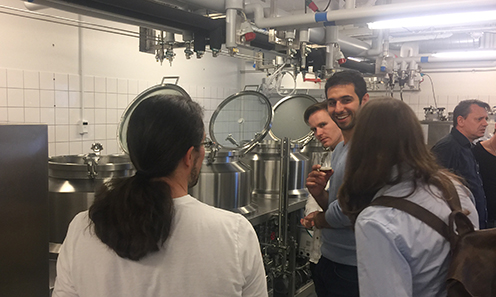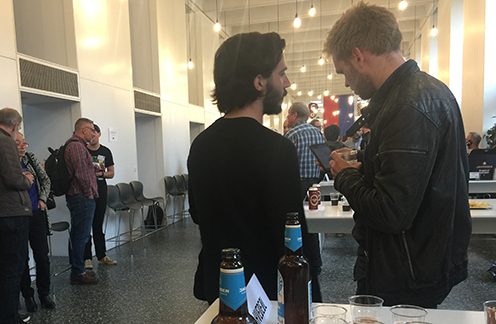Forskning og fag mødtes til Beverage Day 2019
Beverage Day blev afholdt for anden gang den 24. maj 2019 på Institut for Fødevarevidenskab på Københavns Universitet (KU FOOD), hvor forskere og repræsentanter fra drikkevareindustrien, iværksættere, studerende med flere mødtes for at udveksle den nyeste viden på området. Foredragsholderne anlagde mange forskellige vinkler på drikkevarer - fra nye råvare-tendenser - over genbrug af vand i produktionen - til øl uden eller med et lavt indhold af alkohol og nye smagsvarianter.
Læs abstracts fra de forskellige indlæg nedenfor (engelsk)
Fotos: Lene Hundborg Koss






Abstracts - Beverage Day 2019
New raw materials in brewing
Zoran Gojkovic
Director of Brewing Science and Technology, Carlsberg Research Laboratory
Barley (Hordeum vulgare) was one of the first and earliest crops domesticated by humans. Today, barley is the fourth most important crop in the World and it is the primary cereal for brewing beer. Modern breeding techniques produced high yielding varieties, but the selection of a small number of strains resulted in a relatively narrow gene pool, thus domestication has led to significant loss of genetic diversity in barley. The best malting varieties rapidly take up water during steeping, deliver high enzyme activity and high extract potential. The majority of brewers value these characteristics more than the choice of barley variety has on flavor. Unfortunately, most brewers have been content to use malts that eased processing irrespective of the final beer taste. The craft beer movement has re-introduced a strong differentiation of barely heritage and focuses more and more on barley flavor. The barley breeding effort of Carlsberg Research Laboratory combines decades of expertise to provide both beer lovers and brewers with barley varieties delivering good taste, quality and even positive environmental impact. As the interest for barely varietal flavor continues to increase, the work on trying to better understand and develop different barley varieties will never stop.
Product environmental footprint
Eskild Andersen
Sustainability Manager, Carlsberg Breweries A/S
Calculating a product’s carbon footprint is a complex issue, and many results cannot be compared becausedifferent standards have been used. However, with the new EU standards for calculating a product’senvironmental footprint (PEF) and development of sector and product specific standards more transparency is expected. The brewing sector is among the front runners with pilot testing the newly developed product specific standards, so in future calculating a beers environmental footprint will be aligned and thus comparable. The presentation will outline the experiences from the development of PEF standard and the pilot testing.
Water reuse in the food industry: Drivers, challenges and opportunities
Susanne Knøchel
Professor, Department of Food Science, University of Copenhagen
The food and beverage industry is a major consumer of fresh water and there is an increasing interest globally in saving water and reducing discharge to improve sustainability as well as economy. Both international and national guidelines have now opened up for the possibility of using fit-for-purpose water, however, using other than drinking water quality may present challenges with safety and quality assurance, regulations, documentation, customer perception, investment costs and more. At FOOD KU we have worked extensively with reuse of process water and some examples of the research and possibilities will be presented.
Enzymatic cleaning in the food industry
Inge Byg Ulbrink
Research Scientist, Novozymes A/S
Cleaning of food and beverage processing plants should be fast, effective and reliable, resulting in minimal production down time. Currently, cleaning in the food industry is based on acidic and caustic solutions. However, the professional cleaning market is generally moving towards more environmentally friendly and occupationally safe chemicals. Here enzymes can be utilized to clean food processing equipment under milder conditions than currently applied cleaning conditions. The application of enzymes in industrial cleaning can furthermore lead to improved and targeted cleaning, extended equipment lifetime and reduced production downtime.
No & low alcohol beer
Kim L. Johansen
Director, Scandinavian School of Brewing
Beer with a low content of alcohol has gained increasing popularity the recent years. Technologies for production of low alcohol and non-alcoholic beer can be divided into two categories: 1) You can restrict alcohol formation during fermentation or use low alcohol producing yeasts or other microorganisms. 2) You can remove the alcohol from beer with normal alcohol content. Different methods within these two categories will be presented with results from research and with examples of equipment.
The use of Pichia kluyveri for the production of low alcohol and non-alcoholic beer
Sofie Saerens
Department Manager Wine & Fermented Beverages, Chr. Hansen
Today beers with low and no alcohol content are often made by producing full-strength beer and then removing the alcohol by physical processes. At Chr Hansen A/S, a highly innovative patented technology was developed to overcome the drawbacks of the current methods. The technology is based on the findings that a highly aromatic yeast species, Pichia kluyveri, is capable of producing high concentrations of desirable ester compounds from the monosaccharides present in the wort with limited ethanol production. This results in low and non-alcoholic beers with a flavor profile that is close to beers of the same type with normal alcoholic strength.
The Nordic Beer Garden: From the time of the Vikings to today’s special brews
Nathalie Ahlstrand
Postdoc, Natural History Museum of Denmark, University of Copenhagen
No one can deny that beer has played an integral role in Nordic society over time. A new exhibition at the botanical garden in downtown Copenhagen explores the role of beer and especially the plants used inbrewing beer from the time of the Vikings, through to the Middle Ages and into today’s modern Nordicbrews. The exhibition holds more than 30 varieties of history and commercial hops, and over a hundred other plants used through time to conserve and flavour Nordic beer. The garden has been designed to provide a new and exciting way to tap into and tell stories about beer related research taking place in Nordic lands, while connecting and informing garden visitors about the importance of plants and natural history to our beer brewing history.
Danish Hops – breaking the dormancy
Oliver Kemp
Project Scientist, Carlsberg Research Laboratory
Hops are of increasing interest to brewers and consumers alike, as the craft brewing industry has put more emphasis on the role of hops in beer. Therefore, there is a greater demand for new hop varieties with exciting aromas and flavors. In Carlsberg we used to have our own hop breeding program led by Øjvind Winge.While nothing much has happened in 50 years, we have recently started “The Hop Project”, which aims topick up where Øjvind left off and break the dormancy on Danish hops.
Efficient dry hopping technologies for small and large breweries
Alyce Hartvigsen
Iso-Mix & Fermentation Manager, Brewery Systems, Alfa Laval
Increasing demand for craft-style IPAs and pale ales has resulted in the implementation of dry hopping in larger industrial breweries. However, there are a number of challenges associated with the dry hopping process, including long residence times, high product losses and the ever-present risk of carryover of hop solids and blockages of process equipment, resulting in costly downtime. Alfa Laval has developed two new systems to enable fast and effective dry hopping, one for smaller craft breweries, the other for medium to large craft and industrial sites. In this presentation, we will introduce these two technologies and review the principle and benefits of each one.
Beer with fruits
Torben Toldam
Associate Professor, Department of Plant and Environmental Sciences, The Pometum, University of Copenhagen
Use of fruits and berries in beer is internationally well known but in Denmark it is only found to a limiteddegree. However, use of local fruits and berries is a powerfull way to add ‘local terroir’ and storytelling tothe beer. The addition adds aroma, flavor and color as the most obvious qualities. However, also effects on pH and foam characteristics may be very important impacts. Selecting the right cultivar and the method of addition as well as the amounts are critical factors to concider. The experience from small scale experiments are discussed and ideas for potential use and product development are presented. Experimental beers with blackberries and gooseberries will be available for tasting.
Fermentation in casks & bottles
Henrik Siegumfeldt
Associate Professor, Department of Food Science, University of Copenhagen
Fermentation or conditioning in either a cask or a bottle, is a unique way of preparing a beer. This procedure involves leaving yeast in the serving container, so that chemical, physical and microbiological changes occur continuously until the beer is served. This provides for an additional set of desirable flavours, but also with the risk of unwanted flavours.
Chemistry of long term ageing in casks and bottles
Mogens L. Andersen
Professor, Department of Food Science, University of Copenhagen
The chemical reactions that deteriorate aroma and flavour of fresh beer are also the key reactions driving the slow development of pleasant flavours and tastes during long-term storage of beer. The outcome of the ageing reactions depends on the beer style, time, temperature and presence of oxygen. Understanding the limiting factors for these reactions is required for a controlled production of beer with aged notes.
Staling aldehydes from wort to beer
Maciej Ditrych
PhD student, KU Leuven, Belgium
aldehydes may also be released from non-volatile precursor forms, so-called bound state aldehydes etc. Moreover, aldehydes may also be released from non-volatile precursor forms, so-called bound state aldehydes. Therefore, to unravel another puzzle piece of beer flavour instability, we have monitored the staling aldehydes from wort to aged beer. The presentation will discuss the status of staling aldehydes during brewing, fermentation and beer aging processes and identify the critical steps for improved beer flavour stability.
Instrumental measurement of flavor perception
Mikael Agerlin Petersen
Associate Professor, Department of Food Science, University of Copenhagen
Instrumental measurement of odorants has developed significantly over the past decades. Initially only the major volatiles could be detected, but as sensitivity of analytical methods improved, most researchers aimed at identifying as many of the volatiles in a product as possible. Nowadays focus is more on identifying the compounds that are most important for the perception of a product, and they are not necessarily the major ones (by amount). The newest techniques will be described and examples of obtained results will be shown.
Representative Sampling - an overlooked process in the beverage industry
Carsten Rosendal
Business Development, Keofitt
The biggest potential risk factor in quality control is probably the lack of attention to one of the smallest, yet, most critical components: the sampling device and how it is being used. Cross-contamination, down-time and unsafe release of the product are only some of the possible consequences. Learn about the pitfalls in sampling and how to always obtain a small representative quantity of the process media by choosing suitable equipment, installing it correctly and training operators to sample the right way.
Consumer information and introducing beer tasting
Niels Hald
Secretary General, Danish Brewers’ Association, Chairman of the Board of Scandinavian School ofBrewing
Over the past 10 – 15 years consumers have witnessed an increasing number of new beers and beer styles on the market, and with 1.825 new beers in 2018 it becomes increasingly difficult to guide consumers to theright beer. However, the members of the Danish Brewers’ Association have decided to do exactly that: toprovide consumer with more information. What it is and how it will be implemented by the brewers will be presented.
Emner
Relaterede nyheder
Kontakt
Professor Mogens Larsen Andersen, Institut for Fødevarevidenskab (KU FOOD), mola@food.ku.dk
Specialkonsulent Henriette Hansen, Institut for Fødevarevidenskab (KU FOOD), henha@food.ku.dk
eller
Kommunikationsmedarbejder Lene Hundborg Koss, Institut for Fødevarevidenskab (KU FOOD), lene.h.koss@food.ku.dk
